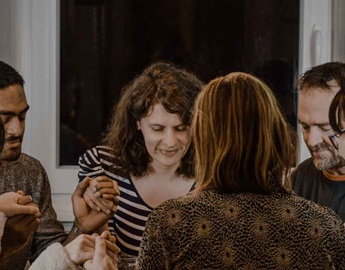Authentic ministry in a virtual world
Troy Emenecker
Guest writer
Point Magazine // May 2022
On a Sunday morning in late March, a woman and her son stood in the courtyard outside the main entrance to Sun Valley Community Church’s Gilbert, Arizona, campus. Still 30 minutes before the 9 a.m. service, the area was empty, until a volunteer emerged from inside to greet her and ask how her morning was.
To which she responded, “This is my first time here.”
About 15 minutes later, in another world ― well, another reality, to be exact ― a man stood inside a church building, looking around, seeing only a few people nearby, when a volunteer approached to greet him and thank him for coming.
To which he responded, “Well, this is my first time here.”
The past two years have certainly forced Sun Valley and countless other churches to seek ― or at a minimum, consider ― new ways to connect with its members and reach nonbelievers. Online services, weekly prayer meetings and small groups gathering via Zoom and live streaming have become part of the new norm for many.
In recent months, however, Sun Valley has broken ground in a reality all its own: virtual reality. And this is what enabled the two aforementioned first-timers to experience the same service simultaneously: one person on the church’s Gilbert campus, the other wearing a headset somewhere ― anywhere ― else.
Still in its infancy, Gilbert’s new virtual reality service is another opportunity to expand their outreach. This new innovative technology is enabling them to share God’s love with people who otherwise might not be reached and to help them understand the gospel.
Last July, Jason Burgoyne, then a youth pastor in Texas, moved to Arizona to become Sun Valley’s first online pastor. Mika Casey, the church’s digital strategies lead director, saw a need for the position because the church shifted to a nearly 50/50 split in live versus on-demand attendance.
Casey said having a pastor dedicated to the church’s online congregation demonstrates their commitment to the needs of what now represents nearly 50% of its weekly attendance.
“Jason’s presence validates those who attend online,” he says. “We now have someone who is in the driver’s seat of that role, watching out for that ministry at all times.”
A few weeks after joining the staff, Burgoyne shared with Casey an idea for a virtual reality-type setting for a church. The two began researching the concept extensively, invested $600 in a pair of Oculus headsets and eventually approached lead pastor Chad Moore and Sun Valley’s executive team about the idea.
“They came to me with this idea,” Moore recalls, “and I asked them, ‘Is anybody else doing this?’ They said, “No,” and I said, “Well, let’s do it.”
Thinking outside the box is nothing new for Sun Valley, which operates six campuses and is partnering with God Behind Bars to open a prison campus later this year. The same is true, Moore understands, of the technology and the next generation of churchgoers.
They came to me with this idea, and I asked them, ‘Is anybody else doing this?’ They said, ‘No,’ and I said, ‘Well, let’s do it.’
Chad Moore
“My 13-year-old son has a headset, and I’ve checked out a few experiences with it,” he said. “This is second nature to my son. We always say that the church is not a building or a place. It is a movement that you choose to be a part of to help people meet, know and follow Jesus.”
Indeed, though it may look different from other church campuses, Sun Valley’s virtual campus is another opportunity to reach people with God’s love, share the life-changing gospel of Jesus Christ and walk alongside them on their faith journey.
Sun Valley connected with Meta’s Horizon Venues platform and, beginning last November 28, became the first faith-based church to offer weekly streaming services to those with Oculus Quest devices. Each week, attendees can engage in Sun Valley’s worship and sermon up close and personal with other viewers from anywhere in the world.
My virtual self
In writing about Sun Valley’s new technology, I put on a headset in Burgoyne’s office at the Gilbert campus and checked out a service for myself. Here is what I learned:
The environment essentially is another Sun Valley campus.
While Horizon Venues is the platform for streaming the weekly service, Sun Valley has built a campus on Horizon Worlds. Visitors can interact with others while checking out what is designed to look like a church campus, complete with a virtual coffee bar and basketball court.
Before the service, I (well, my virtual self) first walked into the virtual church’s main building with Adam Mayhugh, one of four service volunteers. We were soon joined by the first-time visitor described at the beginning of this story. The man had heard about Sun Valley from his son, whose headset he was borrowing.
When it was time to join the service, our new friend and Mayhugh and I had to switch over to Horizon Venues. Burgoyne said the two platforms are expected to merge this year, making the experience easier and allowing it to be more fluid and interactive.
It felt as if I was in church with other people.
Each service “session” can reach a capacity of 20 people. Once a session reaches capacity, a new one opens and new attenders join that service as part of a new group. The virtual auditorium we inhabited felt similar to a youth group gathering, with people standing and plenty of space to move around. A large, movie theater-like screen was at the front of the virtual worship center.
Mayhugh was the service volunteer in this session (each session has a different volunteer). He spent the pre-service time virtually walking around and talking with those there (Burgoyne wants to get shirts for the volunteers’ avatars to wear to make them easy to identify). Once the worship band appeared on the screen, those in attendance responded similarly to what you would expect in an onsite service: some with hands up, others just observing.
The service is interactive.
Most in attendance are familiar with interacting virtually, and this option is available during the service. For example, as the worship band played, Mayhugh went around to high-five and encourage others. However, I could mute myself and/or others if I wanted to experience the service on my own.
Because the service itself is prerecorded, I experienced the same announcements, music and message as those who watch online. The difference, though, is that Burgoyne, who moves between sessions during the service, is available in the pastoral role. Casey says the role is key to legitimizing the virtual reality service as an actual ministry seeking to bring people to Christ.
Other service components, like giving and baptism, aren’t virtual, but they are still prioritized.
Those who express an interest in baptism can connect with Burgoyne or a volunteer, and Sun Valley will send them a baptism kit and walk them through the process. As for tithing, the service includes multiple bumpers that flash across the screen to encourage churchgoers to give.
Casey says these are essential parts of building a relationship with the online and virtual community.
“We have to give them the opportunity to be part of creating the culture,” he said. “We have to tell online baptism stories, make the online aspect more of the church’s overall experience.”
Moore agreed, saying creating the culture needs to be a point of emphasis in the future.
“We feel this is the next area in which the church is evolving,” Casey says.
MetaVerse employs 50 percent of its staff in the virtual reality realm alone. Roughly 2.5 million people use Horizon Apps each month.
“Things are moving very fast in this area,” Casey says. “And it makes sense. The appealing part of VR is the face-to-face. People want this rather than Zoom meetings. They feel more connected.”
We have to give them the opportunity to be part of creating the culture. We have to tell online baptism stories, make the online aspect more of the church’s overall experience.
Mike Casey
According to Burgoyne, 75 percent of Sun Valley’s virtual church attendees are men around the age of 30. A self-admitted gamer who also happens to be 29, he sees his enthusiasm for the technology as beneficial and necessary.
“Yeah, it’s second nature to me,” he says. “I don’t consider myself an expert, but I know enough to figure it out, and Mika takes care of the tech side.”
When it comes to seeking out those who walk through Sun Valley’s virtual auditorium each Sunday, Casey credits Burgoyne’s experience working with youth and his overall approachable nature.
“Jason will talk to anybody, and he does,” Casey said. “He does such a great job connecting with online attendees, online volunteers, meeting with them during the week for coffee.
“What he does essentially tells them, ‘We (Sun Valley) care about you.’”
This care has extended beyond Sunday services. Two small groups, initially established by Burgoyne, meet virtually every week in Horizon Worlds in a home-like setting. Using the previous Sunday’s sermon as a guide for discussion, volunteers lead the groups, which follow the schedules of those who meet in person.
This March, Casey hosted a baptism at his house for three women, part of a group of eight women spread across the country but connected through Sun Valley’s virtual reality ministry. The group members who couldn’t join them in person witnessed the celebration by watching on Zoom. In addition, between six and eight virtual attendees have said yes to Jesus by sending a text message to a number provided toward the end of the message.
New style, familiar challenge: maintaining healthy growth
All of this has occurred with little or no local promotion. No Sun Valley virtual reality attendees are local, and the church only recently began featuring the virtual option on its website.
Burgoyne says that with how quickly the technology continues to evolve, learning to sustain this virtual ministry is enough on its own, even as it also grows. During an average week, 300-400 visit Sun Valley’s Horizon Worlds campus, with 100 staying for an entire service.
“The challenge is maintaining a healthy, weeklong ministry,” he said. “We would rather grow in a way that we under-promise and then over-deliver.”
This includes understanding what the church envisions for the environment of the Sunday service.
“Eventually, the capacity for a service will be more than 20,” Burgoyne said. “Do we want it to be more than that? Do the people who attend want a large crowd of up to 1000, or do we stick to 100, which maybe we can better manage? We’ve talked about whether to have a host, like the in-person campuses, where that host can more personally meet the needs of the virtual community.
“I’m glad we get to do this. Things are developing at such a fast rate that in this position, we really are learning as we go, and it’s exciting.”
Troy Emenecker, Guest writer
Troy Emenecker is a freelance writer for Converge. He attends a Converge church in Mesa, Arizona.
Additional articles by Troy Emenecker


